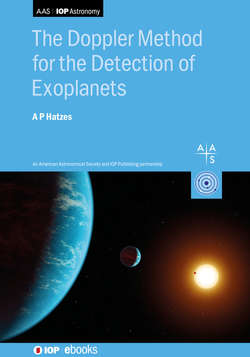Читать книгу The Doppler Method for the Detection of Exoplanets - Professor Artie Hatzes - Страница 7
На сайте Литреса книга снята с продажи.
Preface
ОглавлениеThe first radial velocity (RV) measurements on a star using the Doppler method were made late in the 19th century. The discovery of the first exoplanet, found using the Doppler method, was made near the end of the 20th century. Why did the discovery of exoplanets take nearly one hundred years? In short, it is due to the spectacular improvement in the measurement precision—a 10,000-fold increase over the past 100 years, with most improvements occurring in the past few decades. This is the subject of this book.
The field of exoplanets has developed into one of the most exciting and vibrant fields in astronomy, and that is all owed to the Doppler method. By discovering the first exoplanets, it essentially created the field. Although the detection efficiency of exoplanets using the Doppler method has been surpassed by the photometric transit method, the Doppler method still plays a vital role in confirming transit discoveries and giving a mass, one of the most fundamental parameters of a planet. It is one of the few methods (along with astrometry) that gives you a “dynamical” mass—dynamical in the sense that one derives the mass using the laws of Kepler and Newton, rather than statistics and theoretical models. The Doppler method still ranks as one of the most important exoplanet detection methods in use today.
The pioneering transit-search space missions COnvection ROtation and planetary Transits (CoRoT) and Kepler have produced a treasure chest of transiting planets. As of this writing, NASAʼs Transiting Exoplanet Survey Satellite (TESS) is performing a transit survey among the brightest stars in the sky, and the RV community has its hands full determining the mass for candidate transiting planets. For all of these missions, ground-based spectroscopic measurements, in particular RV measurements, have played a vital role in characterizing the planet discoveries. Within a decade, the PLAnetary Transits and Oscillations of stars (PLATO) mission of the European Space Agency will also search for transiting planets around bright stars, but with the goal of finding Earth-like planets in the habitable zone of stars. So, the Doppler method is poised to continue its important role in exoplanet studies well into the 2030s.
Although almost 1000 exoplanets have been discovered with the Doppler method, this book will not focus on the results from the various RV planet search programs. This can be gleaned from the literature or from Perrymanʼs The Exoplanet Handbook. Rather, this work will focus purely on the method. This includes how one can achieve a high RV measurement precision as well as the challenges, limitations, and potentials of this technique. It will include other aspects of the method, such as instrumentation, wavelength calibration, finding periodic signals in RV time series, interpreting the signals that you find, and Keplerian orbits. An important aspect is stellar variability, which has been known to trick more than a few astronomers (this author included) into thinking that they have discovered an exoplanet. In short, it will cover every aspect needed for one to detect exoplanets with the RV method, a sort of “handbook” for the Doppler method.
If the reader wants to purse RV follow-up of transiting planets from space missions or wants to perform exoplanet RV surveys, this book should be useful. When it comes to exoplanet discoveries, it is easy to fall into traps, to be misled, or to arrive at erroneous conclusions. As the physicist Richard Feynman once famously said, “Science is a way of trying not to fool yourself. The principle is that you must not fool yourself, and you are the easiest person to fool.” This is especially true in the field of exoplanets. I hope that this book will ease the path of those embarking on the use of the Doppler method for the detection and characterization of exoplanets and hopefully, to avoid pitfalls.
